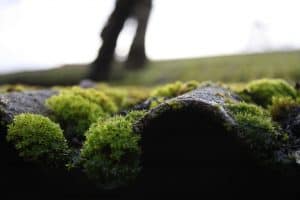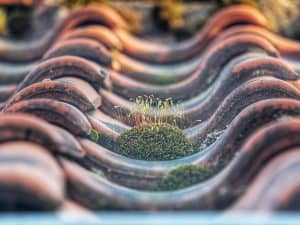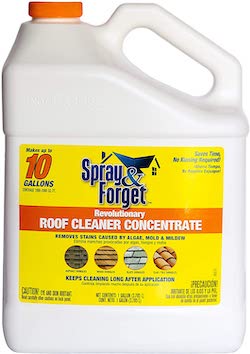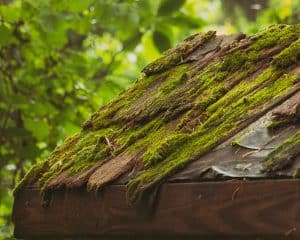If you are a homeowner, you take extra care to maintain the area in which you live. That includes your roof. During rainy seasons or if the environment allows for it, you may wonder about moss taking root on your roof. You may ask yourself, “is moss bad for my roof? Should I worry about moss? Will it damage my roof? If it is bad, how do I remove it? How can I prevent it?”
Moss seems harmless, right? You see it in picture stories in fairytales, so really, what’s the harm? Maybe you’ve seen a house with a steep roof covered in moss, giving it a charming appearance. But there is a darker side to moss. This is your essential roof care guide!
Is Moss Bad for My Roof?
Simply put, moss is harmful to your roof. Moss grows exceptionally well in dark, cool, wet climates. This makes the possibility of moss growing on your roof dependent on the environment in which you live. Even though moss is terrible and can need treatment does not necessarily mean that you need an entirely new roof. Moss does not always indicate damage, especially if you take preventive steps and catch it early.
Why is it bad for my roof?
Moss, by nature, is wet. The consistent moisture on your roof can cause rot and decomposition. When it grows, moss steadily pushes under shingles, tiles, and shakes. It weaves its way under your roofing material, pushing it up and causing damage. This can lead to holes and, eventually, leaks. If the nuisance of moss growing and distorting your roof isn’t enough, bugs and rodents may become more attracted to your roof.
All of these things can surprisingly lead to an unwanted amount of added weight to your roof. Moss is porous and holds a lot of water weight. The potential of hundreds of pounds added to the weight on your roof that it was not meant to support can also cause damage.
If you are considering selling your home, some homebuyers can be particular. Moss on your roof can indicate that it is not well taken care of, and the buyers’ interest may drop. If you are part of a Homeowners Association, they may be particular about the moss and issue you a fine. Roof safety is important, moss can also be dangerous to try and walk on. Because it is moist, it is more likely that you can slip and fall.
Should I remove the moss from my roof?
Someone should remove the moss from your roof, whether it is you or a professional roofing contractor. If your roof is experiencing moss in small areas you may be able to remove the moss yourself. It’s important to take proper safety measure prior to removing the moss. If your problem is more substantial you will need to take a more comprehensive approach to removing the moss.
How do I remove moss from my roof?
If you notice you have moss on your roof, you will want to have it thoroughly cleaned and remove the moss. If the moss is growing in small patches or sections, you can remove it yourself by cleaning it off of your roof. You can remove moss on an as-needed or seasonal basis.
Tools and Materials
- Ladder
- Rubber gloves
- Garden hose (with spray nozzle)
- Soft-bristle scrub brush
- Commercial cleanser
- Pump spray bottle
- Non-slip shoes
- Eye protective gear
![]() Start freeing the shingles by gently brushing away moss by hand or by hose. Make sure to use a lower water pressure if you decide to hose it off. When you use a hose, spray at a downward angle. You can use compressed air to blow away the loosened debris off your roof.
Start freeing the shingles by gently brushing away moss by hand or by hose. Make sure to use a lower water pressure if you decide to hose it off. When you use a hose, spray at a downward angle. You can use compressed air to blow away the loosened debris off your roof.
You can also use a soft-bristled scrub brush, scrubbing in a downward motion. Rubbing downward helps to keep your shingles from being lifted. When rubbing, make sure to do so gently and to work one small section at a time. By taking it section-by-section, you avoid damaging your shingles.
You can also purchase a store-bought or homemade cleaning solution to remove moss. If you have stubborn moss, you can find a variety of commercial cleaning solutions or even make your own. It’s best to treat your roof on a cloudy day so that the solution doesn’t evaporate too quickly. If you decide to use a spray, make sure to follow the directions for application. Some cleaners need to be rinsed, and others need to be left to sit.
How to prepare to get moss of of my roof
Be mindful that commercial and homemade solutions can cause damage to sensitive plants. They can also discolor or cause damage to your home if they are not used properly. If you want to protect your plants, you can spread a sheet below where you are working on the roof. Chemical treatments can also cause irreversible damage to lead flashing. This can result in a stained roof or even structural damage.
It’s essential to think about the structure of your roof when going on it. Walking on the roof can cause damage to the roof. It is not worth damaging your roof and risking personal injury while working on your roof.
If you do not feel comfortable treating your roof by yourself, get professionals to help you get the job done. In some cases, moss can cause serious damage. If your roof has had moss on it for an extended period, do not try to remove it. Contact a local, experienced roofing expert to do an evaluation. You should seek a professional opinion before you decide to remove the moss or repair your roof.
What Not to Do
Whatever you do, do not pressure wash your roof, especially if you have composition shingles. Pressure washing can damage your shingles and shorten the lifespan of your roof. Pressure washing also pushes moisture even further into your roof. This can cause long-term damage. Pressure washing also does not always remove all of the moss between shingles.
You may be considering household cleaning products or bleach to kill off the moss. While bleach and other cleaners can help kill it, using these products can damage your home’s exterior. This can cause structural issues or discolorations. You won’t want just to kill the moss. You’ll also want it to be removed.
Protecting Your Home
The best way to protect your home is by taking preventive action! Keeping your roof clean and maintained are two of the best ways to prevent moss growth. Preventive treatments help kill moss and stop it from growing. Using a water-based zinc treatment to kill most is effective on composition and tile roofs. Once the moss has died, you’ll want your roof sprayed so that the shingles are completely soaked with the solution. This will help to ensure that new moss does not take root.
Copper treatments can be used on cedar shake rooftops. Copper treatments also help to repel insects and protect your roof’s structure. You can also have strips of zinc or copper-coated sheet metal installed. Copper is more effective against preventing moss growth, but zinc is less expensive. Sheet metal rolls can be purchased and cut into appropriately sized strips. When attaching the pieces, use roofing nails or screws with a rubber washer
Other Preventative Measures
Other preventive measures you can take include having your trees pruned, keeping your gutters clear, and regularly having your roof inspected. By pruning your trees, you remove overhanging branches that could potentially drop moss onto your roof. Sunlight helps to remove moisture naturally. Keeping gutters clear helps ensure that moisture doesn’t sit around near the roof. Having consistent inspections prevents the growth of moss.
Remember that removing the moss that fills the space and gaps around your shingles or tiles will likely cause them to rest awkwardly. If possible, you want to remove moss as soon as noticed to prevent further issues.

Eco-Friendly Living Roofs
Another way to protect your home is to allow your green, moss-covered roof to exist. Some people prefer the aesthetic it can bring to their eco-friendly roof. It’s common in eco-friendly communities. By growing plants on the roof, you can cut down on heating costs and improve the biodiversity in your area. You provide a habitat for local insects and animals.
If you are interested in leaving moss on your home, consider your environment, surrounding trees, and climate. If it is warm for most of the year, you may choose to leave moss with the minor risk of shortening your roof’s lifespan.
However, if you are interested in encouraging biodiversity, you should consider creating a proper living roof. It should be done carefully and not allowed simply to grow on or around existing tiles. When a “living roof” is properly maintained, it is waterproof with a root barrier that prevents the surface of your roof from becoming damaged permanently. Larger roofs need reinforcement.
Ultimately, leaving moss on your roof causes damage. To find the best solution, you should talk to your local roofer. Their professional opinion can help you to make an educated decision that best suits your roof. You will also be able to avoid personal injury, risk, or damage to your roof. Cleaning your roof can require specific equipment. If you don’t have what is needed or feel that you can adequately remove the moss, stay safe, and contact a professional.
Expert Home Report keeps you and your home’s safety first. We understand that taking care of your home’s roof can seem like a tremendous job and quickly become frustrating. Don’t rush the cleaning and care of your roof to try and reach the result faster. This will only lead to further issues. Remember to take your time to deal with your roof care needs properly by using one of the best roof moss removal tools that one can buy online.




